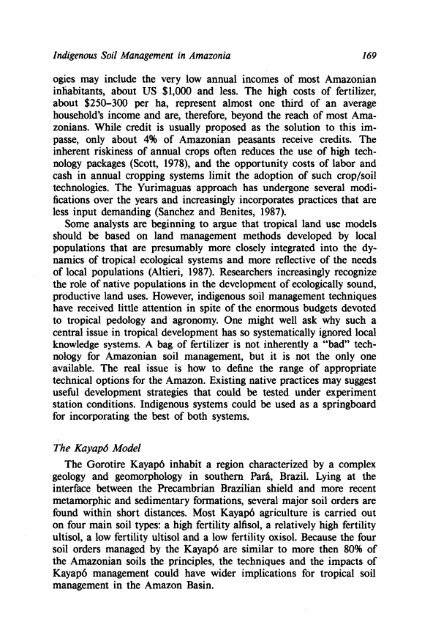Fragile Lands of Latin America Strategies for ... - PART - USAID
Fragile Lands of Latin America Strategies for ... - PART - USAID
Fragile Lands of Latin America Strategies for ... - PART - USAID
Create successful ePaper yourself
Turn your PDF publications into a flip-book with our unique Google optimized e-Paper software.
Indigenous Soil Management in Amazonia 169<br />
ogies may include the very low annual incomes <strong>of</strong> most Amazonian<br />
inhabitants, about US $1,000 and less. The high costs <strong>of</strong> fertilizer,<br />
about $250-300 per ha, represent almost one third <strong>of</strong> an average<br />
household's income and are, there<strong>for</strong>e, beyond the reach <strong>of</strong> most Ama-<br />
zonian~. While credit is usually proposed as the solution to this im-<br />
passe, only about 4% <strong>of</strong> Amazonian peasants receive credits. The<br />
inherent riskiness <strong>of</strong> annual crops <strong>of</strong>ten reduces the use <strong>of</strong> high tech-<br />
nology packages (Scott, 1978), and the opportunity costs <strong>of</strong> labor and<br />
cash in annual cropping systems limit the adoption <strong>of</strong> such crop/soil<br />
technologies. The Yurimaguas approach has undergone several modi-<br />
fications over the years and increasingly incorporates practices that are<br />
less input demanding (Sanchez and Benites, 1987).<br />
Some analysts are beginning to argue that tropical land use models<br />
should be based on land management methods developed by local<br />
populations that are presumably more closely integrated into the dy-<br />
namics <strong>of</strong> tropical ecological systems and more reflective <strong>of</strong> the needs<br />
<strong>of</strong> local populations (Altieri, 1987). Researchers increasingly recognize<br />
the role <strong>of</strong> native populations in the development <strong>of</strong> ecologically sound,<br />
productive land uses. However, indigenous soil management techniques<br />
have received little attention in spite <strong>of</strong> the enormous budgets devoted<br />
to tropical pedology and agronomy. One might well ask why such a<br />
central issue in tropical development has so systematically ignored local<br />
knowledge systems. A bag <strong>of</strong> fertilizer is not inherently a "bad" tech-<br />
nology <strong>for</strong> Amazonian soil management, but it is not the only one<br />
available. The real issue is how to define the range <strong>of</strong> appropriate<br />
technical options <strong>for</strong> the Amazon. Existing native practices may suggest<br />
usehl development strategies that could be tested under experiment<br />
station conditions. Indigenous systems could be used as a springboard<br />
<strong>for</strong> incorporating the best <strong>of</strong> both systems.<br />
The Kayapb Model<br />
The Gorotire Kayap6 inhabit a region characterized by a complex<br />
geology and geomorphology in southern Par& Brazil. Lying at the<br />
interface between the Precambrian Brazilian shield and more recent<br />
metamorphic and sedimentary <strong>for</strong>mations, several major soil orders are<br />
found within short distances. Most Kayap6 agriculture is carried out<br />
on four main soil types: a high fertility alfisol, a relatively high fertility<br />
ultisol, a low fertility ultisol and a low fertility oxisol. Because the four<br />
soil orders managed by the Kayap6 are similar to more then 80% <strong>of</strong><br />
the Amazonian soils the principles, the techniques and the impacts <strong>of</strong><br />
Kayap6 management could have wider implications <strong>for</strong> tropical soil<br />
management in the Amazon Basin.

















